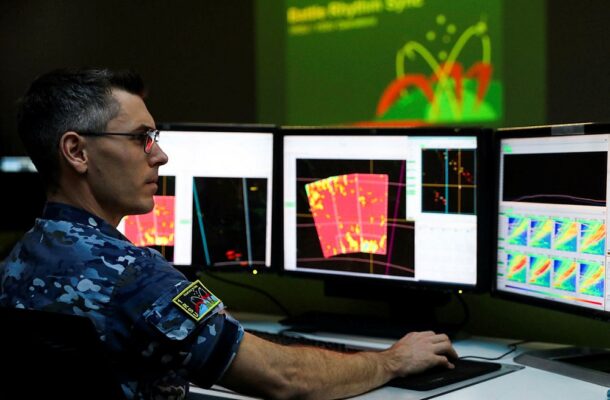Keeping Australia safe in space

The joint statement issued after Saturday’s AUSMIN meeting in Brisbane declared enhanced space cooperation as a new force posture initiative for the United States and Australia in ‘this critical operational domain’. The two governments also announced an intention to increase space integration and cooperation in operations and exercises.
These are important steps, but there are challenges ahead, particularly in terms of how the Australian Defence Force ensures access to space in the face of growing threats from adversary counterspace capabilities. That’s the ‘contested’ part of the oft-quoted observation about space being ‘congested, contested and competitive’.
Australia’s 2020 force structure plan noted the challenge in a section titled ‘space control’, highlighting the need for space domain awareness. On the more challenging issue of responding to counterspace threats, it stated:
Defence will need capabilities that directly contribute to war fighting outcomes in the space domain using terrestrial and/or space-based systems. The Government’s plans include the development of options to enhance ADF space control through capabilities to counter emerging space threats to Australia’s free use of the space domain and that assure our continued access to space-based intelligence, surveillance, and reconnaissance.
The Defence Department’s 2022 space strategy reinforced a requirement for space control, saying:
Defence will continue to identify Space Control gaps and opportunities to develop a credible Space Control capability, and space capability developers will actively seek to improve the resilience of the space capabilities. Defence will explore options consistent with its commitment to be a responsible actor in space.
However, the public version of the 2023 defence strategic review doesn’t mention space control. Consideration of this important next step for the ADF in space is reduced to a vague statement noting a requirement for ‘capability assurance and communications provision’. The review seems to de-emphasise the importance of having a sovereign capability, noting that ‘sovereign capability needs … must be offset by the cost requirements of such capabilities against opportunities to collaborate with the United States and other partners’.
While no one is arguing for autarky in Australian space capabilities, a retreat to dependency ignores the reality that if we want space assurance, we can’t depend on others to provide it for us. The recent reduction in funding for space development in the civil and commercial sector doesn’t build confidence that there will be a coherent strategic approach to space, especially with a national space policy now looking uncertain.
It’s time for the ADF and Defence Space Command to tackle the challenging but vital mission of space control and develop a policy and capability path towards it.
The beginning of space assurance for the ADF would be the ability to launch Australian satellites on Australian launch vehicles from Australian launch sites on demand. If we continue to rely on others for launch services, we won’t have assured access to space because we’ll be at the end of a queue driven by the interests of, and demands on, the overseas launch provider. That would be illogical. Australia is ideally situated to launch satellites for the ADF, for other areas of government and for broader commercial customers as well as international allies and partners. We must make sovereign launch the centrepiece of any national space strategy.
While a focus on space domain awareness gives us a valuable capability to share the burden with key allies and partners, it should be seen as the first step to a viable space control capability, not the complete solution. Australia can burden-share in orbit to a much greater degree, both by expanding ground- and space-based space domain awareness and by developing its own defensive soft-kill space-control capabilities. The threat is clear. Counterspace capabilities under development by China and Russia include a full suite of ground-launched, co-orbital and ground-based soft-kill and hard-kill systems.
An Australian space-control capability may be seen by some as controversial, but it’s not as if we’re acquiring kinetic-kill anti-satellite weapons, and it’s not unprecedented. Defence announced in 2021 that it was considering a defensive space electronic-warfare capability under Project 9358, noting that such a capability, ‘as part of the Australian Defence Force’s approach to space control, seeks to detect and deter attempts to interfere with, or attack, our use of the space domain’. As a soft-kill capability, space electronic warfare wouldn’t create debris or damage the space environment, the announcement said. That’s also consistent with Australia’s 2022 decision to support the ban on testing anti-satellite weapons that produce debris.
The head of Defence Space Command, Air Vice-Marshal Cath Roberts, has made the case for soft-kill space-control capabilities and has reinforced the importance of electronic warfare to defeat threats in orbit. The combination of assured space access through sovereign launch, enhanced space domain awareness, and a sovereign soft-kill space-control capability based on space electronic warfare is an excellent foundation from which the command can start dealing with space control in the coming decade.
A second step should be mitigating the counterspace threat by emphasising the acquisition and local development of proliferated constellations of small satellites as part of military space architecture, as the US and other allies are doing. Such constellations are much more difficult targets for counterspace capabilities than a small number of large, expensive and complex satellites because they increase the complexity of an attack, and its risk of failure. Small satellites are also better able to exploit locally developed fast innovation cycles and are better suited to emerging sovereign launch capabilities.
For small satellite constellations to provide resilience in space, we will also need to be able to replace them quickly. This should be a priority for Defence Space Command and highlights the importance of future technologies such as reusable launch and hypersonics to offer a high launch tempo matched with an ability to produce small satellites locally. The goal should be to ensure that Australia can rapidly augment and reconstitute space capabilities in the face of counterspace threats, defend those capabilities and deter an adversary from attacking them.
We must be prepared to challenge traditional mindsets on the use of space and be willing to shift away from traditional approaches to the provision of space capabilities in a much more contested domain. If Defence Space Command doesn’t grasp this problem, Australia will be much more vulnerable to an adversary’s space warfighting capabilities.
This article was published by The Strategist.
Dr Malcolm Davis is a Senior Analyst at the Australian Strategic Policy Institute. His research interests include capability development, future warfare and military technology, Chinese military modernisation and Asian security.










